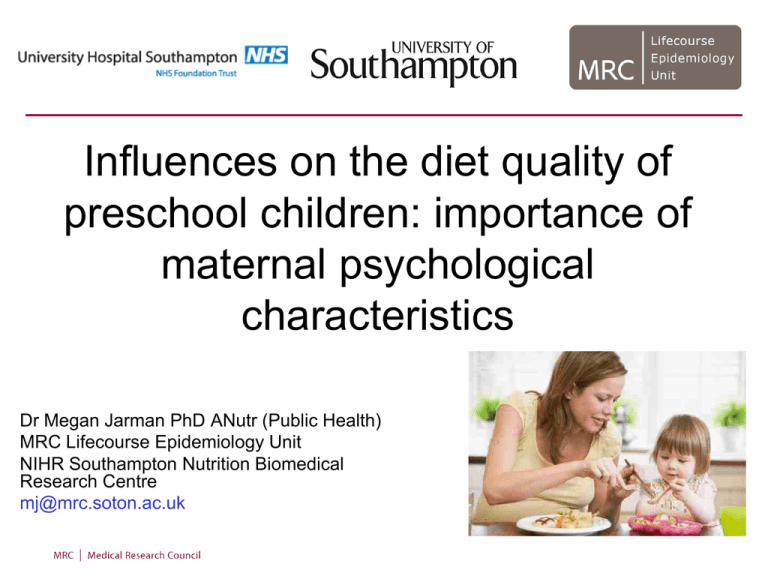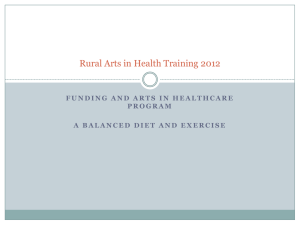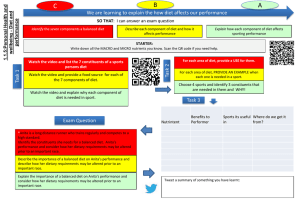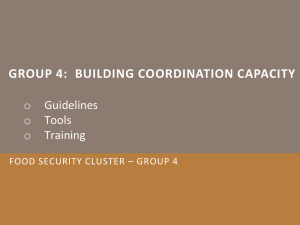Megan Jarman - University of Southampton
advertisement

Influences on the diet quality of preschool children: importance of maternal psychological characteristics Dr Megan Jarman PhD ANutr (Public Health) MRC Lifecourse Epidemiology Unit NIHR Southampton Nutrition Biomedical Research Centre mj@mrc.soton.ac.uk Background • Quality of children’s diet is integral to optimal growth, development and lifelong health • “Poor quality diets are common among children aged 1.5-4.5 years and improving diet quality of preschool children is an important area for investment” (Scientific Advisory Committee on Nutrition) • Maternal, child and home food environment characteristics have been identified as important influences on children’s quality of diet but these are often studied in isolation Maternal psychological factors General control “I think that what happens in my life is Research question: often determined by factors within my control” General self-efficacy “I can overcome challenges in my life” Do maternal psychological profiles predict children’s quality Self-efficacy for healthy of diet? Food involvement “I enjoy cooking for others and myself” eating “I can overcome barriers to having a healthy diet” Well-being “I feel cheerful and in good spirits” Methods • Mothers taking part in the Southampton Initiative for Health, with a 2-5 year old, were invited to complete a survey • A questionnaire was used to collect information on child’s quality of diet, characteristics and the home and mealtime environment • Information about the mother was available from her participation in the Southampton Initiative for Health Quality of diet score Good quality (high score) Poor quality (low score) Maternal and child characteristics N 348 Children characteristics Age Gender Boys Girls Number of children in the house 1 2 3 4+ Maternal characteristics Age Educational level ≤ GCSE >GCSE Mean 3.3 N 177 171 N 110 163 46 29 Mean 33.1 N 134 214 SD 0.9 % 51 49 % 32 47 13 8 SD 5.4 % 39 61 Statistical analysis • A correlation matrix showed that the maternal psychological factors, general control, self-efficacy, self-efficacy for healthy eating, well-being and food involvement were correlated • A cluster analysis was performed on the psychological factors • Cluster analysis is the task of grouping a set of observations such that those in the same group (cluster) are more similar to each other than to those in the other groups. Results 1 Percentage of mothers with scores above the median for psychological factors according to cluster membership Cluster 1 = ‘more resilient’ Cluster 2 = ‘less resilient’ *difference in proportion is significant (p=<0.001) Results 2 Characteristic More resilient Less resilient P Value † Mothers with university level education (n(%)) 63 (31) 19 (15) <0.001b † More than 3 children in the house (n(%)) 33 (16) 37 (30) 0.03b † Household is food insecure/hungry (n(%)) 20 (10) 35 (28) <0.001b 80 (40) 35 (28) 0.052b 164 (84) 88 (71) 0.03b 2 (1.1) 3 (1.3) 0.01a † Child has not consumed take away food in the past 3 months (n(%)) † Child eats meals while sitting at a table more than once per day (n(%)) Child’s average daily screen time in hours (mean(SD)) †Categories displayed are those which show the greatest difference however p-value is a test for trend across all categories for these variables at-test for differences between the means bChi square test for trend across the categories Results 3 Food Water Green vegetables Root vegetables Other vegetables Salad vegetables Wholemeal bread Rice or Pasta Fish Fruit (excluding citrus) Pure fruit juice Crisps Roast potatoes or chips Chocolate or sweets Processed meat White bread Crackers Cakes and biscuits Low calorie soft-drinks Children’s median (IQR) weekly consumption More resilient Less resilient 14 (7-21) 7 (0.5-21) 4 (2-6) 3 (1-5) 3 (2-5) 3(1-4) 2 (1-4) 2 (0.3-3) 2 (0.3-5) 1 (0-4) 6 (2-8) 5 (0.5-8) 3 (2-4) 2 (1-3) 1 (1-2) 1 (1-2) 13 (9-16) 11 (8-15) 1 (0-7) 1 (0-5) 3 (1-5) 4 (2-7) 3 (2-4) 3 (2-7) 3 (2-4) 3 (2-7) 2 (1-3) 2 (1-4) 0.5 (0-4.5) 2 (0-7) 0.5 (0-2) 0.5 (0-2) 3 (2-5) 3 (2-7) 7 (0.5-14) 7 (2-14) P Value 0.02 <0.000 0.03 0.049 0.03 0.69 0.07 0.91 0.02 0.08 0.003 0.47 0.054 0.33 0.050 0.27 0.35 0.04 Results 4 Bar graph showing children’s mean prudent diet score according to mothers cluster membership Results 5 Variable Coefficient 95% Confidence intervals P Value Mother’s cluster membership -0.29 -0.49, -0.08 0.006 Mother’s education (6 categories) 0.15 0.08, 0.22 <0.001 Food insecurity (2 categories) -0.05 -0.11, 0.01 0.09 0.17 0.05, 0.28 0.004 -0.14 -0.21, -0.06 <0.001 -0.08 -0.16, -0.003 0.04 Frequency of child sitting at a table to consume meals (4 categories) Frequency of child eating meals in front of the television (4 categories) Child’s average daily screen-time (hours) Summary • Mother’s who are less resilient tend to manage their children’s mealtime environments differently and have children with poorer quality diets than mothers who are more resilient • These factors are more common in women disadvantaged by lower educational attainment • Interventions to improve children’s quality of diet need to support women to manage their children’s eating habits and mealtime environments in a way that makes them feel more in control Thanks goes to • The women who took part in our surveys and focus groups. • The Southampton Initiative for Health team • Dr Mary Barker, Professor Sian Robinson, Professor Cyrus Cooper, Professor Don Nutbeam • Those who support our work:







